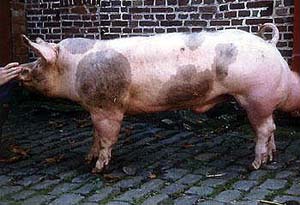Pietrain Swine
 Pietrain, Belgium, the village from which the breed takes its name, was the birthplace
of the breed. The exact origin is unknown but the local breed was "brought to the
fore" during the difficult period of the swine market in 1950-51. The breed became
popular in its native country and was exported to other countries, especially Germany.
Pietrain, Belgium, the village from which the breed takes its name, was the birthplace
of the breed. The exact origin is unknown but the local breed was "brought to the
fore" during the difficult period of the swine market in 1950-51. The breed became
popular in its native country and was exported to other countries, especially Germany.
The breed is of medium size and is white with black spots. Around the black spots there are characteristic rings of light pigmentation that carries white hair. This, coupled with the fact that the black hair is not as deeply pigmented as on black breeds, or the black spots on some spotted breeds, leaves them with less than the most attractive coats. The breed is commonly referred to as being piebald markings. The ears are carried erect.
The type of the breed is quite distinct. They are shorter of leg than most breeds, stockier in build, and quite broad along the back. The hams are extremely bulging and muscular. They carry an extremely high proportion of lean to fat. When compared to the Belgian Landrace which is itself known for its meatiness, they excelled in usable lean, having 66.7 percent as compared to 63.2 percent; in defatted loin they cut out 24.5 percent as compared to 23.4 percent; their hams averages 24.6 percent as compared to 23.4 percent; and in lean to fat ratio, the breed had 9.2 to 1 while the comparison was 6.3 to 1. These comparative figures, and its reputation for very high quality lean, makes the breed a desired one for fresh meat processing. And, most pork is sold as fresh meat in Belgium.
The breed has developed a reputation for improving the quality of market swine when the boars are used on sows of other breeds, especially the Belgian Landrace. While the sows of the breed are prolific, they lack some in mothering characteristics and in milk production.
Pietrain swine were imported in Germany in 1960-61. The main breeding areas in that country are Schleswig-Holstein, Nordrhein-Westfalen and Werttemberg-Baden. They are commonly used in crossbreeding in Germany to improve the quality of pork produced.
While the Pietrain has recently been losing popularity in its native country, it does have the potential for providing genetic improvement in carcass quality. In Belgium, the breed is tested regularly for the selection of superior performing lines of swine in the eight test stations that are scattered over the country.
References
Briggs, Hilton M. 1983. International Pig Breed Encyclopedia. Elanco Animal Health
